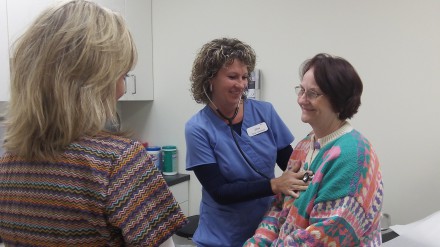Lunch Break Health Care
Jane Werner was having heart trouble. She had no energy and felt like sleeping all the time. Her doctor told her to exercise and lose weight. She tried that. Then she tried vitamins. Nothing was working.
“You exercise and you don’t feel any better and you wonder if there’s anything else out there,” she said. Just as she was about to start looking for a new doctor, she learned that a health center had just opened up at Hillenbrand, Inc., where her husband worked as an engineer. She thought she’d give that a try.

A typical patient to the Health and Wellness Center receives at least a 20-40 minute appointment with the physician on duty
When she walked in the doors of the Health and Wellness Center—located on the grounds of Hillenbrand’s operation in Batesville, Indiana—she was amazed by the attention she received. Up until this point, Werner was used to quick in-and-out visits with a physician, lots of paperwork, and relatively impersonal interactions with the office administrators and nurses. But this time, she felt like she was really being cared for. The nurse practitioner gave her a full 20-minute appointment and took her concern seriously by referring her to a cardiologist who would investigate her heart issue more thoroughly and ultimately diagnose her with cardiac ejection fraction, a condition that would improve through therapy.
“I’ve never had such a caring experience in my life,” Werner expressed.
On top of that, Werner didn’t have to pay a cent for her visit to the center, not as a copay then or later.
Lean Business, Bulky Health Benefits
In August 2012, Hillenbrand, Inc.—an Indiana-based global industrial company, perhaps best known for its subsidiary Batesville Casket Company—was named by the Indianapolis Business Journal as the “Healthiest Employer in Indiana.”[1] The reason behind the award began back in 2009 when the company’s leadership began noticing a trend that didn’t sync with their commitment to lean business practices.
“We spend a lot on health care . . . a lot,” explained Julie Joerger, human resources director for Hillenbrand’s mergers and acquisitions department. “Not that we mind spending a lot on health care—because it’s important—but every year, we spend more and we don’t get anything more for that dollar.”
It didn’t make sense. Even though the company was spending a significant, ever-increasing amount on health care every year, the health of its employees was not improving, many with health issues related to preventable diseases. As Joerger and others began to dig deeper into what was really going on with their employee health care situation, they discovered other things they didn’t like.
On a typical visit to the doctor, an employee would spend an average of 2 hours 10 minutes in the waiting room filling out tedious paperwork and only 6-8 minutes with the physician (just five percent of face-to-face time). Then the employee would have to take more time off work waiting for a prescription to be filled at the pharmacy. Joerger and her team realized they were losing on multiple fronts: from a cost perspective (both for Hillenbrand and the employee), an employee satisfaction perspective and a productivity perspective.
So Hillenbrand applied its business sense to the problem and asked the question: Why not take our health care in house? Doing this, perhaps they could eliminate the burdensome and wasteful elements of their health benefits while giving the employee a much better experience when going to the doctor.
Three years earlier, someone else had been asking the same question.
Minus the Middle Man
A few folks from an Indianapolis underwriting company, Novia Underwriters, Inc., had begun noticing that many companies were assuming huge financial burdens to provide health benefits to their employees. In fact, since 2001, the cost to the employer to provide such benefits was on its way to increasing by more than 75 percent. On top of that, they noticed that many insurance companies weren’t doing a good job of providing tools for people to take charge of their health. Most people knew what their insurance premium cost, but they didn’t know much about how to maintain their health or what to do to avoid preventable diseases.
“Some employers [had] employees who [would] define themselves as ‘healthy’ because they hadn’t been to see a doctor in years,” explains Eric Olson, one of the former underwriters and current CEO of Novia CareClinics. In reality, these employees could be time bombs for diseases that could be prevented or managed if they were diagnosed in time.
But what if someone could help stop the unnecessary escalation of risk factors into full-blown disease, help people take better charge of their health, and provide a more cost effective option for both employers and their employees—all at the same time?
And that’s how the first Novia CareClinic came to be. The idea was to help employers create on-site wellness centers[2] that would provide primary care services to their employees, all the while cutting out the middle man of insurance. Novia estimated that the typical employer would recoup the cost of the initial investment within 12-15 months and increase employee health and company productivity in the long haul.
In 2007, Batesville Tool & Die, a metal stamping company in Indiana, was the first company to use Novia to start a clinic. By the end of 2012, Novia had 50 center locations, servicing more than 85 employers across five states—Indiana, Colorado, Georgia, Mississippi, and Ohio.
Although large companies like Hillenbrand are able to supply enough patients for one clinic, in other cases, a group of smaller businesses have banded together to create a shared clinic for their employees.
A Pound of Cure
On any given day at the Hillenbrand Health and Wellness Center, an employee/patient will walk through its doors into a warmly lit waiting room of the almost 6,000-square-foot primary care and occupational health medical building equipped with six examining rooms, a consultation room, a lab, an emergency eye-washing station, and an audiometry room. After being greeted by a member of the nursing team, the patient quickly signs in, no lengthy insurance paperwork required.
The patient is then ushered into an examining room for a 20 or 40-minute appointment with the physician on duty. The physician focuses on preventative care by discussing life factors that contribute to or prevent illness—not simply on “fixing” a current concern. At this point, the patient’s medical history is entered into an electronic records system that will track his or her medical risks—commonly things like high blood pressure, high cholesterol, obesity, smoking, etc.—This data is then shared with the Healthy Living Disease Management group, who can provide consultation and incentives for healthier life habits and managing their condition. If a patient has a condition that is beyond the realm of primary care, the physician will refer a patient to an outside specialist. This preventative approach is also intended to reduce the number of expensive health claims and improve company productivity, by catching and preventing diseases that could incapacitate an employee.
If the patient needs a prescription filled, he or she doesn’t have to worry about taking extra time off work to make a run to the pharmacy, but can choose from a variety of generic prescriptions available at no cost to the patient, if they get them at the Health and Wellness Center.
Less than an hour after entering the Wellness Center, the employee is out the door and back to work.
In the two years since the Wellness Center opened, the numbers point to the success of the concept and implementation of employer-provided clinical care. From 2009 to 2010 (the year the Center opened), the number of Hillenbrand employees and family members who got annual physicals increased 283 percent—a positive step for disease prevention. For employees with diabetes, there was a 10 percent improvement in overall test results.
The dollar signs have been encouraging too. While a visit to the Wellness Center doesn’t cost a penny for the employee, Hillenbrand ends up paying less too, with an employee visit to the center costing 33 percent less than an employee visit to an in-network provider and 44 percent less expensive than a visit to an out-of-network provider.[3] A lab draw from the center costs 97 percent less than a lab draw at a hospital, and 69 percent less than at an average primary care doctor’s office. To date, Hillenbrand’s overall healthcare costs are trending at about a third of the national average and workers’ compensation claims have been reduced by an average of 25 percent since 2009.
Good Old Fashioned Medicine
Nurse practitioner Amy Hummel has enjoyed her job much more since she began working full time for the Wellness Center. Before that, she had worked at a private practice and later at a hospital, where she said she spent much of her time “twiddling her thumbs” waiting for patients to finish filling out paperwork. At Hillenbrand, Hummel says she is able to spend 50 percent more time with patients.
“Taking out the insurance leaves us more time to see the patient,” Hummel explains. It also leaves her more time to ask more questions and make sure she’s accurately diagnosing the problem.
On average, she sees 15 patients a day—20 minutes with those with basic issues, like a cold or an ear infection, and 40 minutes with those getting a physical or specific test. This extra time gives Hummel increased opportunity to discover secondary health concerns that might become more serious issues down the road.
She remembers a woman who came to get simple blood work done for thyroid issues. But when Hummel listened to the patient’s heart she detected a “horrendous murmur.” Through an in-office EKG, Hummel determined that the woman was in the beginning stages of heart failure. Now the woman is on a heart pump and doing fine.
“It could have been complete heart failure,” Hummel admits. “She thought she was just getting blood work done, but because we had the extra time together, we found more.”
In addition to eliminating the insurance bottleneck, the new system has also opened the lines of communication between those caring for the patient and those who are employing him. In a few cases, an occupational therapist at the Wellness Center saw patients who were dealing with work-related injuries and was able to communicate back to the leadership at Hillenbrand, who then made necessary changes to the workplace environment to reduce the likelihood of future injuries.
“There is a two-way conversation between the occupational health provider and the workplace,” says Joerger.[4]
Through all of the little decisions to cut down on time and financial waste, Hillenbrand’s ultimate goal is to look at the big picture of wellness. For them, wellness is not just physical health. It’s also financial health—not having to drain one’s bank account to pay a hospital bill. It’s productivity—not having to miss an entire day of work to take a sick child to the doctor. It’s creating a workplace that is free from occupational frustrations and, if not free of hazards, capable of addressing potential problems on site. It’s also the comfort one receives when they know they are being treated as a whole person, not simply a name on a chart.
“I wish we would have had this year’s ago,” says Werner.
[1] In the 1,500-4,999 employees category
[2] A wellness center differs significantly from a medical clinic. A wellness center provides primary and preventative care with a focus on overall employee fitness and function, whereas a medical clinic is concerned primarily with treating acute needs.
[3] Hillenbrand employees are still free to use other providers if they do not want to use the Wellness Center or need more specialized care.
[4] This kind of feedback loop is unusual in the world of medical care, where most hospitals have no idea how a patient is getting along after a surgery or procedure until the next time the patient feels the need for medical intervention.






